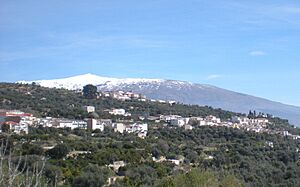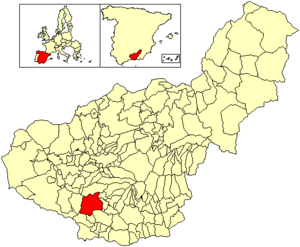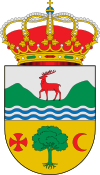Albuñuelas facts for kids
Quick facts for kids
Albuñuelas, Spain
|
|||
|---|---|---|---|
|
village
|
|||
 |
|||
|
|||

Location of Albuñuelas
|
|||
| Country | Spain | ||
| Province | Granada | ||
| Municipality | Albuñuelas | ||
| Area | |||
| • Total | 140 km2 (50 sq mi) | ||
| Elevation | 730 m (2,400 ft) | ||
| Population
(2018)
|
|||
| • Total | 830 | ||
| • Density | 5.93/km2 (15.4/sq mi) | ||
| Time zone | UTC+1 (CET) | ||
| • Summer (DST) | UTC+2 (CEST) | ||
| Website | www.albunuelas.es | ||
Albuñuelas is a small village in Spain, located in the Lecrin Valley near Granada. It has three main parts: Alto, Bajo, and Fernán Núñez (also called La Loma). This village is part of the European route Nº 4, which stretches all the way from Spain to Crete.
History of Albuñuelas
People have lived in the Albuñuelas area since the late Palaeolithic era, which was a very long time ago. We don't know exactly when the village started. The ancient Greeks brought better ways to grow vines (for grapes) and olives to Spain. They also taught people how to use irrigation to water crops. The name Albuñuelas comes from the Latin word 'vinolea', meaning an area with vines. This suggests that vines were grown here even before the Romans arrived.
The Romans were in Spain from 220 BCE to 409 CE. They found small villages made of adobe (a type of mud brick) and whitewashed. The Romans called this province Betis. They grew vines and grains here, and also mined minerals. These goods were then sent back to Rome. You can still find old mine openings around the village today.
Later, the Moors lived in this area. You can see proof of their time here in the Torre del Tio Bayo. This is an eight-metre-high (26 ft) tower built around the mid-1300s, during the later Nazarí period. In the 1100s and 1200s, new ideas in hydraulics (how water moves) helped farming. The large Roman farms, called latifundia, were replaced by smaller Arab farms, known as minifundia, during the Al-Andalus period.
Albuñuelas is in an area where earthquakes happen often. A big earthquake hit on December 25, 1884. The village was badly damaged. This was partly because of landslides caused by the land's shape and soil. More than 70% of the houses fell down. The rest were seriously or slightly damaged. The upper part of the village was hit the hardest. Sadly, 102 people died, and up to 500 were hurt.
Economy of Albuñuelas
The main ways people make a living in Albuñuelas are by growing timber, almonds, and olives. These crops are found on the Sierras de Albuñuelas mountains, which reach 1426 meters high at Herrero. Sometimes, you might see farmers using mules to work the land on the terraces (flat steps cut into hillsides). But more often, they use modern farm machines. In the past, the main crop was cereals (like wheat). However, due to climate change, farmers now mostly grow citrus fruits (like oranges and lemons) and other fruits that like warmer weather.
Natural History
Two main streams flow through this area: Albuñuelas stream and Barranco de Luna. Both of these streams start in the Sierra de Albuñuelas mountains. They carve out the eastern edge of the Albuñuelas plateau.
See also
 In Spanish: Albuñuelas para niños
In Spanish: Albuñuelas para niños



